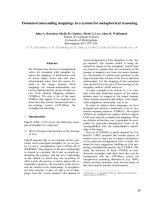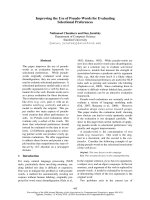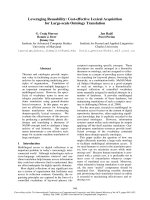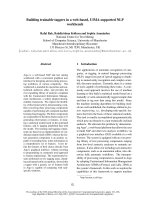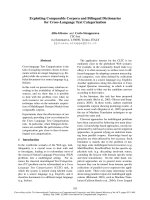Báo cáo khoa hoc:" Does computer use pose a hazard for future long-term sickness absence?" potx
Bạn đang xem bản rút gọn của tài liệu. Xem và tải ngay bản đầy đủ của tài liệu tại đây (156.48 KB, 3 trang )
BRIE F REPO R T Open Access
Does computer use pose a hazard for future
long-term sickness absence?
Johan H Andersen
1*
, Sigurd Mikkelsen
2
Abstract
The aim of the study was to investigate if weekly duration of computer use predicted sickness absence for more
than two weeks at a later time.
A cohort of 2146 frequent computer users filled in a questionnaire at baseline and was followed for one year with
continuously recording of the duration of computer use and furthermore followed for 300 weeks in a central regis-
ter of sickness absence for more than 2 weeks.
147 participants of the 2,146 (6.9%) became first time sick listed in the follow-up period. Overall, mean weekly
computer use did not turn out to be a risk factor for later sickness absence. The hazard ratio for sickness absence
with weekly increase of one hour in computer use was 0.99 (95% CI: 0.99 to 1.00). Low satisfaction with work place
arrangements and female gender both doubled the risk of sickness absence.
We have earlier found that computer use did not predict persistent pain in the neck and upper limb, and it seems
that computer use neither predicts future long-term sickness absence of all causes.
Findings
Computer use has for decades been associated with
musculoskeletal pain problems, especially with acute
pain, but less evidence exists on prolonged or chronic
pain problems and consequenc es on sick leave. In gen-
eral, computer professiona ls and technicians have been
found to have a low risk of sickness absence [1], but
this was based on a small sample of the Danish work
force, and none of the studies, which have been per-
formed among computer users, has analyzed the relation
between computer use and sickness absence in detail.
Recently, methodologies for assessing work activity dur-
ing computer use has been evaluated, and activity-based
recordings of computer use seem to be reliable and in
agreement with measures obtained by observational
techniques [2-4]. Two studies have used objective mea-
sures of computer activity, and found no association
between computer use, mouse use or keyboard use in
relation to the risk of persistent symptoms in the neck
and upper limbs [5,6]. In this study we aimed at asses-
sing if duration of computer use was a ssociated with a
later risk of prolonged sickness absence (e.g. sickness
absence for more than 2 weeks) for all causes.
We used a compu ter programme (WorkPaceRecorder ,
Wellnomics LTD/ErgoDirect) to record usage patterns
for computer usage, and summarized usage parameters
into mean weekl y hours of using the computer for one-
year from 2000 to 2001 among 2146 technical assistants,
which was a subgroup of the NUDATA-study [5,7-10].
For computer usage time an interval of 30 seconds
between events of using the computer was used as cri-
terion for usage, allowing for reading from the screen
andthinkingaboutthenextinputmovetobeincluded
in the measure of computer usage time. In order to
reduce a huge amount of data, we summed daily statis-
tics to weekly values to form WPR computer time
(hours per week (h/w)).
These data has afterwards been linked to a nationwide
regist er of sickness absence for more than 2 weeks - the
DREAM-database. The DREAM database includes infor-
mation on all public transfer payments administered by
Danish ministries, municipalities, and Statistics Denmark
for all Danish citizens on a weekly basis since 1991,
including granted sick ness absence compensation since
1996 [11]. Each person was linked by th e way of their
unique personal registration number, obtaining a data-
base with baseline information and ob jective recording
of computer use for one-year. In addition the database
included recordings of sickness absence for more than 2
* Correspondence:
1
Danish Ramazzini Centre, Department of Occupational Medicine, Herning
Hospital, 7400 Herning, Denmark
Andersen and Mikkelsen Journal of Negative Results in BioMedicine 2010, 9:1
/>© 2010 Andersen and Mikkelsen; licensee BioMed Central Ltd. This is an Open Access article distributed under the terms of the
Creative Commons Attribution License (http://creativecom mons.org/licenses/by/2.0), which permits unr estricted use, distribution, and
reproduction in any medium, provided the original work is properly cited.
weeks from the beginning of data collection (the day
they filled a baseline questionnaire) and 300 weeks
forward.
From a baseline questionnaire a series of covariates
regarding physical, psychosocial and individual charac-
teristics were included in the analyses. They have earlier
been described in detail [5,7-10]. In short, these vari-
ables were individual factors: gender, age, type A beha-
viour, negative affe ctivity, private social support, medical
diseases with potential to influence neck and upper limb
pain status, and accidents involving injury of the neck
or shoulder; psychosocial work environment factors: job
demands, job control, social support, job satisfaction
and time pressure at work; ergonomic factors: abnormal
position of mouse or keyboard, lack of arm/wrist sup-
port, height of screen, and adjustable work desk and
chair. To account for other aspects of the arrangement
of the workplace, a “mixed” ergonomic/psychosocial
variable ( “How satisfied are you with the overall arrange-
ment of your work place?” ) with response alternatives
very satisfied, satisfied, neither satisfied or unsatisfied,
unsatisfied, very unsatisfied, don’t know was included.
Seniority was assessed by the length of time partici-
pants had used a computer at work to the same extent
as currently, divided into less than three years, four to
seven years, eight to ten years, and more than 10 years.
Data were analyzed by complementary log-log (CLL)
regression for interval-censored survival times, where
the time variable for week number was introduced into
the model as an indicator variable: The CLL model is a
discrete analogue of the continuous proportional
hazards model. The outcome was time to first appear-
ance of a sickness absence period for more than 2
weeks, with computer time as the explaining variable.
Only those weeks where the participant was at risk of
being sick-listed were counted (e.g., if people were
unemployed for some weeks, this would not count as
time at risk). Those participants who emigrated, retired
or died during the follow-up period were censored.
The effect of computer time was estimated as a linear
effect and by categories of computer time. A standard
set of potential confounders was used for all analyses
and included 1) individual factors, 2) psychosocial work
environment factors, 3) ergonomic factors and 4) job
task seniority in years of working with a computer. All
analyses were conducted in STATA version 10.0.
The mean computer use among the participants was
9.2 hours per week (SD = 6.3 hours per week). One
hundred and forty seven participants of the 2,146 (6.9%)
became first time sick listed in this period of 300 wee ks.
The average risk time per per son (table 1) was similar
for the different computer time groups indicating that
the results on sickness absence could not be explained
by other differences in public transfer payments between
the exposure groups. The hazard ratio for sickness
absence with weekly increase of one hour in computer
use was 0.99 (95% CI: 0.99 to 1.00). Table 1 shows the
hazard ratios for sickness absence divided in to cate-
gories based on weekly usage times. The risk estimates
were all around 1 without any pattern of exposure
response between computer use and risk of sickness
absence. The results were similar when we divided com-
puter use into its main elements: mouse use and key-
board use. There was no effect of years working with a
computer. Women had more than a double risk for
sickness absence compared with men HR = 2.6 (2.4-2.8).
Other factors associated with sickness absence were ear-
lier accidents in the arm-hand region (HR = 1.7(1.5-2.0)).
BMI below 20 predicted sickness absence (HR = 2.6
(2.3-3.0)), and for BMI > 30 the risk was 3.1 (2.8-3.4).
There were some effects of psychosocial work place
factors, (high job demands (HR = 1.6 (1.5-1.8)), low
satisfaction with work place arrangements (HR = 2.1
(1.9-2.3)). Questions on different aspects of ergonomic
Table 1 Risk estimates for sickness absence for more than 2 weeks in relation to mean weekly computer use
Computer use
Hours/week
Number of Participants
N = 2,146
Sickness absence
> 2 weeks
(%)
Mean number weeks
at risk
per person
Sickness absence
HR (95% CI)
Unadjusted
Sickness absence
HR (95% CI)
Adjusted*
0-<2.5 365 7.3 257 1.00 1.00
2.5-<5 230 6.0 261 0.91
(0.82-0.99)
1.07
(0.96-1.20)
5-<10 628 7.1 261 1.05
(0.98-1.13)
1.19
(1.10-1.30)
10-<15 540 6.9 260 1.09
(1.01-1.17)
1.09
(0.99-1.19)
15-<20 276 6.0 262 1.09
(0.99-1.19)
1.04
(0.93-1.16
> 20 107 6.3 263 1.08
(0.96-1.23)
0.94
(0.82-1.09)
*Hazard ratios with 95% confidence intervals obtained by complementary log- log regression for interval-censored survival times. Adjusted for individual
characteristics, psychosocial work environment factors, ergonomic factors and computer work seniority (years).
Andersen and Mikkelsen Journal of Negative Results in BioMedicine 2010, 9:1
/>Page 2 of 3
factors e.g. screen position, keyboard and mouse posi-
tion, adjustable table and chair did not have any effect
on sickness absence.
This paper presents risk estimates for sickness absence
for more than 2 weeks in a cohort of computer users.
We found no risk of higher sickness absence in relation
to higher weekly usage of the computer. Higher sickness
absence in this cohort was associated with female gender,
low and high BMI, earlier injuries in the upper extremity,
high job demands and overall low satisfaction with the
work place arrangements, despite no specific effects of
ergonomic factors. This study benefits from a homoge-
neous population of technicians, and the group that only
uses their computer to a small extent (from zero to 2.5
hours per week), and who was used as the reference
group was not exposed to hazardous non-office expo-
sures. They attend meetings, talk in telephone and do
other office work. Computer use was objectively regis-
tered for one-year, and we cannot exclude the possibility
that usage pattern could change in the follow-up period,
which were 300 weeks. If we restricted the analyses to
the year of exposure measurements or the following year
the associations were no different than reported in this
paper. Introducing variability values for weekly computer
use into the model did not change the estimates. We
have no knowledge of reasons for sickness absence. Sick-
ness absence is a complex sociological phenomenon with
occupational as well as non-occupational determinants.
Musculoskeletal disorders and common mental health
problems are among the most important factors in long-
term sickness absence. The DREAM-register only con-
tains information of granted sickness absence compensa-
tion whatever the background and diagnoses. We
hypothesized that if there were strong adverse health
effects of computer use, which have been claimed for sev-
eral years, it would show up as later sickness absence.
But, we acknowledge that an effect on musculoskeletal
sickness absence could be diluted by measuring all-cause
sickness absence. Another explanation for the negative
association between compute r use and sickness absence
could be that ailments in the form of pain problems from
neck and upper extremity do not hamper the ability to go
to work and therefore does not cause sickness absence.
A Dutch study found that among computer users with
neck/shoulder symptoms or hand/arm symptoms loss in
productivit y derives from a decreased perfo rmance at
work and not from sickness absence [12]. Fi ndings from
earlier studies support that pain in the neck and upper
extremity among computer usersismostlyacuteand
transient pain, and in studies with clinical examinations
very few diagnoses could be obtained [7,9,10]. Two recent
studies found no association between recorded computer
use and persistent pain [5,6]. So, we feel confident in
concluding that computer work probably is associated
with pain problems now and then, but the risk of more
persistent or chronic disorders is small, and as this study
reveals, does not cause long-term sickness absence.
Author details
1
Danish Ramazzini Centre, Department of Occupational Medicine, Herning
Hospital, 7400 Herning, Denmark.
2
Department of Occupational Medicine,
Copenhagen University Hospital, Glostrup, Denmark.
Authors’ contributions
JHA and SM conceived of the study, and participated in its design and
coordination and helped to draft the manuscript. JHA and SM participated
in the design of the study and JHA performed the statistical analysis. All
authors read and approved the final manuscript.
Competing interests
The authors declare that they have no competing interests.
Received: 19 September 2009 Accepted: 22 March 2010
Published: 22 March 2010
References
1. Lund T, labriola M, Villadsen E: Who is at risk for long-term sickness
absence? A Prospektive cohort study of Danish employees. Work 2007,
28:225-230.
2. Homan MM, Armstrong TJ: Evaluation of three methodologies for
assessing work activity during computer use. AIHA J 2003, 64:48-55.
3. Blangsted AK, Hansen K, Jensen C: Validation of a commercial software
package for quantification of computer use. Int J Ind Erg 2004,
34:237-241.
4. Douwes M, Kraker H, de Blatter BM: Validity of two methods to assess
computer use: self-report by questionnaire and computer use software.
International Journal of Industrial Ergonomics 2007, 37:425-431.
5. Andersen JH, Vilstrup I, Lassen CF, Kryger A, Brandt L, Overgaard E,
Mikkelsen S: Computer mouse use predicts acute pain but not prolonged
or chronic pain in the neck and shoulder. OccupEnviron Med 2008,
65:126-131.
6. IJmker S: Risk factors for arm-wrist-hand and neck-shoulder symptoms
among office workers. A longitudinal perspective. PhD thesis VRIJE
University, EMGO Institute, Netherlands 2008.
7. Brandt LPA, Andersen JH, Lassen CF, Kryger A, Overgaard E, Vilstrup I,
Thomsen JF, Mikkelsen S: Neck and shoulder symptoms and disorders in
a Danish cohort of 6943 computer workers. Scand J Work Environ Health
2004, 30:399-409.
8. Mikkelsen S, Vilstrup I, Lassen CF, Kryger AI, Thomsen JF, Andersen JH:
Validity of questionnaire self-reports on computer, mouse and keyboard
usage during a 4 week period. Occup Environ Med 2007, 64:541-547.
9. Lassen CF, Mikkelsen S, Kryger A, Brandt L, Overgaard E, Thomsen JF,
Vilstrup I, Andersen JH: Elbow and wrist/hand symptoms among 6943
computer operators. A 1-year follow-up study (the NUDATA study). Am J
Ind Med 2004, 46:521-533.
10. Kryger AI, Andersen JH, Lassen CF, Brandt LPA, Vilstrup I, Overgaard E,
Thomsen JF, Mikkelsen S: Is intensive use of the arms an occupational
hazard among computer users? From the NUDATA study. Occup Environ
Med 2003, 60:e14.
11. Hjøllund NH, Larsen FB, Andersen JH: Register based follow-up on social
benefits and other transfer payments. Accuracy and degree of
completeness in a Danish interdepartmental administrative database
compared to a population based survey. Scand J Pub Health 2007,
35:497-502.
12. Heuvel van den SG, Ijmker S, Blatter BM, de Korte EM: Loss of productivity
due to neck/shoulder symptoms and hand/arm symptoms: results from
the PROMO-study. J Occup Rehabil 2007, 17:370-382.
doi:10.1186/1477-5751-9-1
Cite this article as: Andersen and Mikkelsen: Does computer use pose a
hazard for future long-term sickness absence? Journal of Negative Results
in BioMedicine 2010 9:1.
Andersen and Mikkelsen Journal of Negative Results in BioMedicine 2010, 9:1
/>Page 3 of 3
